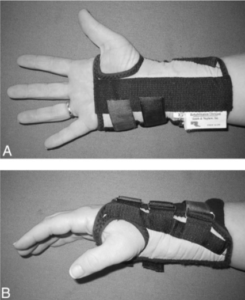Snowboarding is a breathtaking sport yet carries with it an inherent risk of injury. Wrist protectors provide potential protection against snowboarding wrist injuries. However, some studies have argued that wrist protection transfers the injury to other parts of the forearm.
A 2001 joint study by the Lillehammer Central Hospital (Now part of Innlandet Hospital Trust) and University of Oslo Department of Orthopedic Surgery explored the efficacy of wrist protectors in preventing snowboarding injuries.
Studies like this are very important in growing winter sports, as more athletes will pick up snowboarding or alpine skiing if the risk of serious injury can be further decreased.
A total of 5029 snowboarders were included in the study, with 2515 snowboarders wearing a brace and 2514 snowboarders not wearing a brace. The brace used was a D-ring wrist brace. A physician examined the participants at the end of each day snowboarding and was not aware if the subject had worn a wrist protector or not. The physician defined a wrist injury as an evident fracture, sprain, or pain in the wrist that lasted for at least 3 days.

A limitation of this study comes with setting an endpoint for what qualifies as a wrist injury. Both fractures and sprains qualify as wrist injuries. Wrist pain must be accompanied by decreased range of motion for 3 days to qualify as a meaningful wrist injury.
The study results showed that the braced group experienced 8 wrist injuries, while the control group recorded 29 wrist injuries. This is a statistically significant difference in the number of wrist injuries experienced by each group.
Of the subgroups explored in this study, beginner snowboarders with less than 5 days of snowboarding experience were found to have significantly more wrist injuries than the snowboarders with more than 5 or more days of experience.
A snowboard constrains both legs and feet in strapped bindings. When a snowboarder begins to lose their balance, a snowboarder will commonly extend their arms to brace the fall. When the wrist is flexed upwards during a fall, the wrist absorbs the energy of the fall and causes a fracture or sprain.
An effective wrist protector absorbs as much energy as possible without providing additional stress areas to the forearm. A wrist protector that is designed with too much rigidity will generate a high stress force above or below the wrist. The study confirms the benefits of wearing a protective wrist guard while snowboarding, and the physician found no injuries in the arm due to the use of a brace.
However, most wrist guards still available are uncomfortable to wear with winter gloves, so the study recommended future gloves be designed with built-in wrist guards. By improving the safety of alpine sports, snowboarders will feel comfortable pushing the boundaries of the sport and attempting more unforgettable tricks!
For more on injury prevention in snowboarding, check out this article by the Daily Herald or click here.
Featured image by Bradley Dunn on Unsplash

